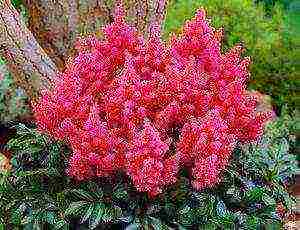Content [show]
 These adorable vibrant colors are hard to look away from. The multicolored petals inspire admiration for the creations of nature. Viola (tricolor violet) in Russia bore the names: scrofula, tricolor, moth, semi-color or pansies. The article is devoted to the nuances of growing this beautiful crop in the open field, within the framework of the article we will deal with the varieties and consider in detail the planting and proper care of the plant.
These adorable vibrant colors are hard to look away from. The multicolored petals inspire admiration for the creations of nature. Viola (tricolor violet) in Russia bore the names: scrofula, tricolor, moth, semi-color or pansies. The article is devoted to the nuances of growing this beautiful crop in the open field, within the framework of the article we will deal with the varieties and consider in detail the planting and proper care of the plant.
Description of the plant: varieties and varieties
Pansies are perennials, but cultivation is usually carried out according to the agrotechnics of a two-year crop. Abundant flowering in the open field occurs in the spring and the first half of summer. Touching flowers open their petals towards the first rays of the sun, as soon as the snow melts.

This variety of violets will be a worthy decoration for any flower bed.
Single flowers with a diameter of 6 to 10 cm rise from the leaf sinuses. Sometimes viola flowers emit a delicate, subtle aroma. The leaves of the plant are delicate, light green, oval, with a crenate or serrated edge.
Cultivated varieties are striking in the splendor of a variety of colors. Breeders have bred a huge number of multi-colored viols, including: the whole range of lilac shades, yellow, white, blue. Pansies of red-brown tones are not uncommon now. High-quality viols have contrasting stripes, eyes, and edging on the petals.
Wittrock's viola classification: varieties and variety series.
Pansies are usually subdivided according to the height of the bush:
- undersized;
- medium-sized;
- tall.
The second sign of the subdivision of viola varieties is by the size of the flower:
- species with large flowers;
- small-flowered varieties;
- with giant flowers.

Variety of viola shades
In addition, pansies differ in the appearance of the edge of the petals:
- even petals;
- wavy edge of the petals.
According to the color of the petals, the following types of viola are distinguished:
- varieties with a monotonous (one-color) color;
- two-tone varieties;
- a series of flower varieties with contrasting spots and stripes.
Pansies make up more than 15 groups of ornamental and garden varieties, which differ significantly in terms of flowering, flower color and size, shape, winter hardiness. Breeders have developed many giant wavy edged varieties, including semi-double and terry varieties. They can grow well outdoors.
The charming flowers of the "Russian size" variety series exceed 10 cm in diameter. New selection - ampelous pansies of the "Waterfall" variety series. These plants are intended for hanging baskets, they are characterized by abundant, lush, long flowering.
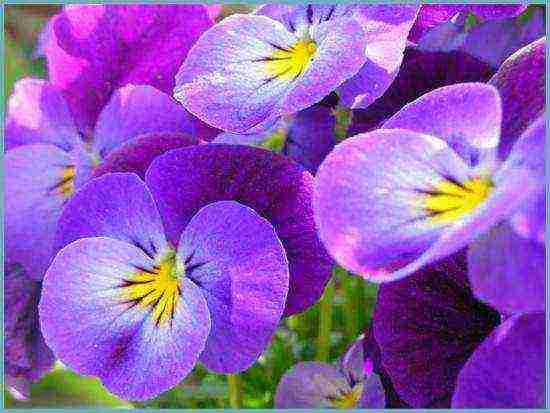
Solid color pansies
In landscape design, monochromatic pansies are popular, the planting of which allows you to delimit the territory of the garden with contrasting colored spots.
Currently, monophonic copies of viola of bright, clean colors have been bred:
- blue;
- purple;
- yellow;
- white;
- orange;
- red.
Planting a plant
The high decorativeness of pansies in the open field directly depends on the landing site. Although the plant is quite shade-tolerant, it degenerates in a thick shade: the flowers become smaller, lose their saturation, the plant stems stretch out, fade. The flowering time of such plants is significantly reduced.
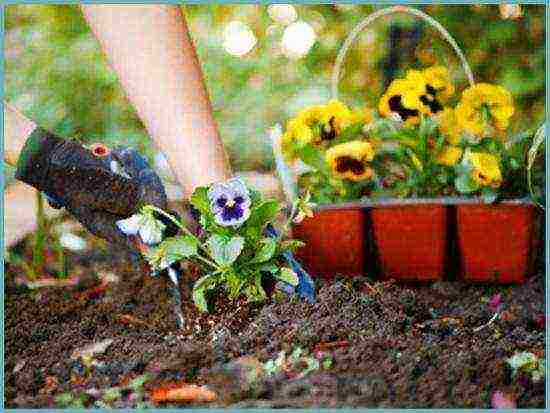
Planting viola in open ground
The second condition for the luxurious flowering of pansies is the soil. Viola does not tolerate dry, rocky, sandy soil. This flower grows well in fertile soil, rich in nutrients and moisture. Viola care is minimal.
How to plant pansies correctly: planting and care
Pansies - planting and maintenance is easy: you can plant the plants directly with seeds in the soil. For this, the soil is loosened, the seeds are embedded shallowly. Watering crops is carefully carried out from a watering can with a fine strainer so as not to wash the seeds out of the soil. Seedlings in open ground appear on the 7-10th day.
To accelerate flowering, you should take care of using the seedling method in advance, when the seeds are sown in a greenhouse or greenhouse in advance. This agrotechnical technique allows you to get richly flowering bushes much earlier than when sowing with seeds. Growing seedlings begins in February. Boxes with seeded viola are kept for a week in a dark place. With the emergence of seedlings, the boxes are transferred to the brightest place. Seedling care consists in timely watering and hardening. Pansy seedlings are planted in the ground in mid-May. Flowering can begin within a month.
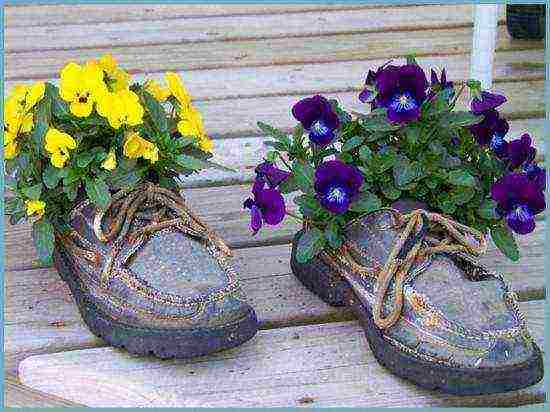
An example of decorating a summer cottage with pansies
Important! Watering the seedlings is required to be carried out regularly, avoiding drying out or waterlogging of the earthen coma.
Viola is an unpretentious plant. Caring for her is not difficult. The plant requires regular watering, but it does not respond well to stagnant water in the garden.
Important! To prolong the flowering of the viola bush and preserve the decorative effect of the plant, faded flowers must be regularly removed. Pinching stimulates the development of lateral shoots, which increases the number of decorative flowers.
Fertilization and feeding
When preparing a bed for planting viola, it is important to provide for the introduction of fertilizers to increase the flowering period. Granular double superphosphate is excellent for this purpose. The fertilizer is embedded in the soil, where it slowly dissolves during the summer season and feeds the plants with phosphorus, which is responsible for the beauty of flowers.

Pansies, like any other plants, need mineral feeding
During the growing season and flowering pansies, it is required to apply complex fertilizer for garden flowers. The frequency of nutrient introduction is made in accordance with the manufacturer's recommendations.
Excellent results are achieved with foliar applications when the fertilizer is sprayed over the foliage.
Important! Pansies do not tolerate manure.
Plant propagation
In addition to sowing with seeds, pansies are easily cuttings. Reproduction of viola by cuttings in the open field is not difficult. Around the beginning of summer, green cuttings with 2-3 internodes are cut from the bushes of the plant. Fresh cuttings are planted in a prepared bed. When planting, the viola should be watered and sprayed with water.

Viola cuttings
Important! The use of growth stimulants (epin, root, heteroauxin) increases the survival rate.
Reproduction of the culture by green cuttings allows you to get a hardened, full-fledged bush, ready to bloom in less than a month.
Diseases and pests
Unfortunately, delicate pansies do not bypass diseases and pests. There are many diseases in pansies:
Powdery mildew affects the entire plant. The affected parts of the flower die off over time, new buds are not formed.
Treatment: a water-soap emulsion is sprayed over the plant.
Gray rot causes damage (decay) of all parts of the plant. Treatment: spraying with a 0.5% solution of copper oxychloride up to 4 times in 1 week.
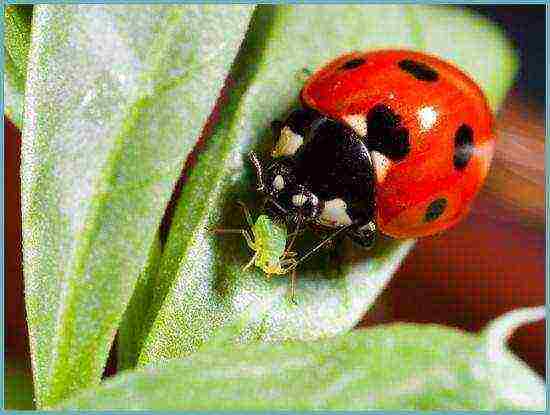
Inspect plants regularly for diseases and pests
Spotting - premature death of leaves; slowdown of flowering. Treatment: the same control measures as for gray rot.
Blackleg - development of rot on the root collar and roots of the flower. It develops with excessive watering, dense soil and stagnant water. Prevention: use of clean planting material, properly organized watering. Cultivation of a crop in a waterlogged garden bed leads to the death of plants.
Pansy pests are aphids and spider mites. Affected plants wither, stop blooming, and eventually die. In case of severe infection, it is required to treat the flower garden with appropriate pest preparations.
Pansies: Combine with other plants
Violet Wittrock goes well with low-growing perennials or biennials:
- Daisy;
- Asters;
- Horned violet;
- Iberis;
- Forget-me-not;
- Lobelia.

Pansies in a flower bed combined with forget-me-not
When planting flower crops together, plants of a suitable size should be selected so that nearby growing specimens do not oppress each other.
An excellent combination in a flower bed is achieved by planting only pansies, while varieties of the same color are selected, or a multi-colored mixture. Such flower beds look elegant and decorative.
Pansies in landscape design
The use of pansies in landscape design is widespread and very justified:
- young crops bloom in the same year (when sown through seedlings);
- a wide palette of colors makes it possible to choose the right variety for any design solution for flower beds;
- flowering culture begins early enough, in the cold spring, when there are few flowering crops.
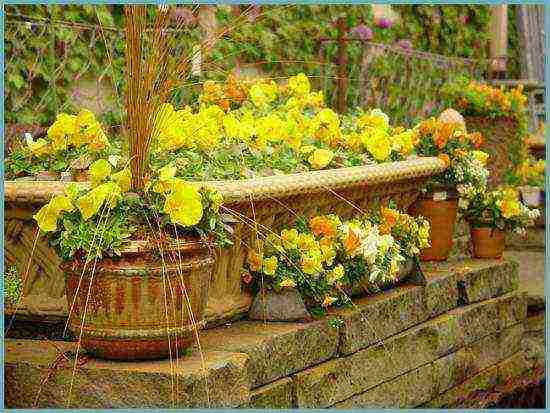
An example of landscape design using monochromatic pansies
Curtains of viola look great on an emerald green lawn. Carpet ornaments are laid out of flowers, paths are planted with them, planted in hanging pots. Planting does not cause trouble and difficulties, and the care of the viola is quite simple, therefore it is often used to decorate territories in landscape design.
Rules for planting viola in the ground: video
Pansies: photo

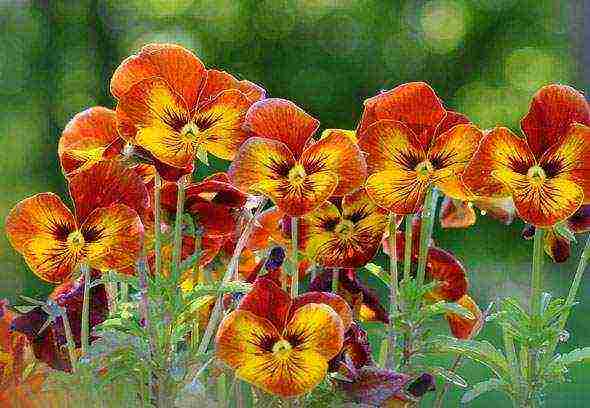
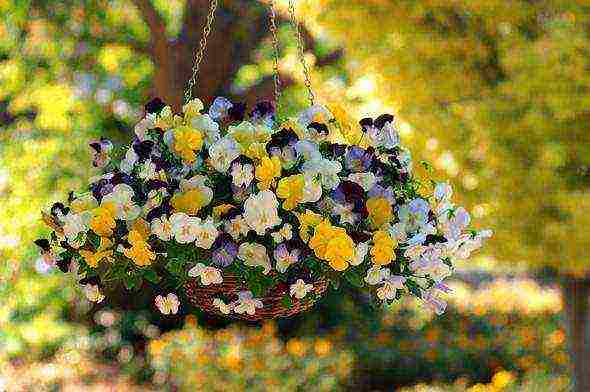

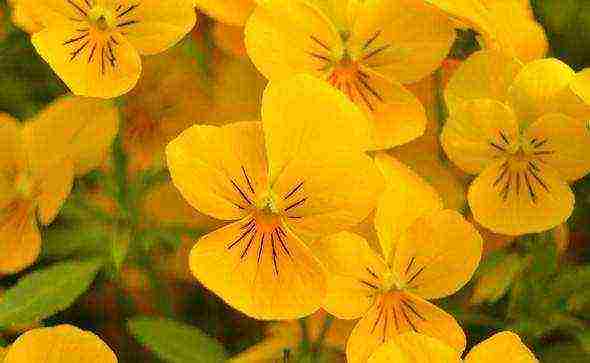
Memories of childhood - grandmother's flower garden, in which she loved to play and his brightest flowers, pansies, planting and caring for which were always entrusted to me, because they are within the power of a child. After, of course, many new varieties appeared, but I always planted the same ones, my grandmother's beloved, with yellow-brown leaves.
Viola, or as these violets are also called, Pansies, she is a tricolor, always decorates many front gardens with multi-colored spots. Easy to care for, but beautiful and not picky, she is one of the many constant pets in my garden.
Content
Pansy flowers - description and varieties
Many are surprised to learn that pansies are perennial plants, we just grow them as a two-year culture. Cheerful eyes begin to appear in the spring and bloom somewhere in the middle of summer.
Compact bushes with lush green oblong-oval serrated leaves are decorated with flowers in spring, with a diameter of 5 to 10 cm, depending on the variety.
By size are divided into:
- Undersized
- Medium-sized
- Tall
By the structure of the flower there are:
- Simple
- Semi-double
- Terry
Flowers with wavy edges look very beautiful. Such varieties began to be bred relatively recently, they are distinguished by a wide variety of colors, with eyes, specks or stripes.
Very often, landscape designers prefer monochrome Violas. A sufficient variety of colors have already been bred:
- White
- Yellow
- Orange
- Blue
- Purple
They come as an addition to other flowers or in a prefabricated flower bed. You can also delimit the space in the garden with different colors. I always plant Pansies in large flowerpots and alternate monophonic with multi-colored ones. I also really liked the ampelous varieties that can be hung under the roof on the terrace and they hang with a large multi-colored hat.
Many people like to plant pansies on their balconies, they are like a bright beacon, attract the eyes. In northern latitudes, it is advisable to plant winter-hardy varieties in open ground.
Different varieties have also been bred in terms of ripening, that is, you can pick up plants so that they bloom one after another. And thanks to breeders, we are able to grow violets with different sizes of flowers, from very tiny to gigantic.
Pansies - planting and care at home
Viola can be grown in two ways:
Seedless, with sowing directly into the soil Seedling, a method that allows you to prolong flowering
I use both of these methods, then the flowering is much longer. The main thing is to choose according to flowering time and color palette.
Landing in open ground
In the open field, sowing is carried out in spring, in April-May, and summer, in July. In the spring, seeds are sown when the weather is favorable. In the Siberian climate, alas, it is not recommended to grow viola in this way. Such flowers will bloom in the same year, but most likely they will not have enough strength to overwinter. Summer planting is better in the sense that the plants have time to get stronger by winter, they will begin to bloom only the next year, thereby preserving the strength for a safe wintering.
For sowing in open ground, it is better to choose small-flowered varieties, since plants with large, double flowers are more delicate and sensitive to cold snaps, although pansies are quite cold-resistant.
Seat selection
For my viols, I choose a light partial shade. In the shade, they quickly become smaller and stop blooming, and in the bright sun, and even with our sultry and dry summer, they are hot, then they stand sluggish, and the tips of the leaves begin to turn yellow.
Pansies also do not like too wet soil, they do not tolerate dampness, so it is better not to plant them in the lowlands.
Sandy, clayey or heavy soil is not suitable for these flowers. On a fertile, loose and water-intensive plant, they will bloom longer and require less maintenance.
Soil preparation
For pansies, it is better to prepare the bed in advance, add humus and sand if your soil is heavy. Do not add fresh manure, viola does not like it, only last year's compost or good humus.
Before planting, I bring in a liter jar of wood ash per square meter, it provides nutrition and protects against fungal diseases.
Seed preparation
For good germination, I soak the seeds for a day in an epin solution. Then I rinse and dry. For disease resistance, you can soak them for twenty minutes in a burgundy solution of potassium permanganate.
You can also feed the seeds in an ash solution, you need to dissolve a tablespoon in a liter of warm water and hold the seeds for two hours in it.
Sowing seeds
Before sowing, we loosen the bed and make grooves of half a centimeter, embed seeds in them, do not tamp tightly. The crops must be watered immediately with non-cold water from a watering can with a spray.Seedlings usually appear in a week or two.
Growing pansies with seedlings
Only the seedling method allows you to get gorgeous flowers this year from early spring. To do this, we need special shallow boxes for seedlings, soil, homemade or from a store and seeds. You need to sow pansies on seedlings in February.
As a soil, you can use the arrogance of garden soil, humus and sand. If there is no humus, you can replace it with peat, but then add leafy soil from the forest. We must steam the soil or spill it with any fungicide, you can use a solution of potassium permanganate for these purposes.
We prepare seeds in the same way as for open ground. We close it up shallowly, you can simply crush it with earth from above and pour it from a spray bottle. Then we remove the box with seedlings in a warm and dark place. It is better to cover it with glass or foil so that the moisture does not evaporate quickly.
After three days, we begin to look in so as not to miss the seedlings. Then we immediately take out the seedlings into the light. Now you need to make sure that the soil is always moist and additional lighting is required, because in February there is not enough light for the plants.
The viola is picked when two or three true leaves appear. It does not require large cups, you can use boxes of dairy products, only rinse them well first.
Ten days before transplanting flowers into open ground, we begin to harden them, gradually take them out into the fresh air in the warmest time of the day. So the plants will get stronger faster and will take root much better.
Pansies - care
One of the most unpretentious summer flowers is pansies, planting and caring for them is a pleasure. If you planted them in the right place and on the right soil, and at the right time, of course, then, without much effort, you will admire the bright and lush flowering for most of the spring and summer.
The most important requirement for this plant for watering, you need to constantly keep the soil around it slightly moistened, do not let it dry out and do not water so that it squishes.
Top dressing
After transplanting seedlings into the ground, the plant should take root and begin active growth. Therefore, at first we do not apply any fertilizers. Then, once every two weeks, you need to feed it with a complex fertilizer for flowering plants. Before flowering, you need to apply fertilizers containing phosphorus, they will prolong flowering, make it especially bright.
In order for pansies to bloom longer, you need to immediately remove faded, wilted inflorescences.
Diseases and pests
Unpretentious flowers, but with improper care they can very easily get sick, however, diseases can be avoided simply by observing agricultural techniques.
Black leg - not only seedlings are sick, but also adult plants, with thickening, when weeds are not removed in time. When there is a constant stagnation of water. Sick plants need to be removed, watering should be stopped for the first time, and the soil should be tamed with wood ash.
Gray rot is also caused by improper care. As soon as signs appeared, we begin to spray the plants with a solution of copper oxychloride for a month, after a week. the same measures help against brown spot, which can cause the death of the plant.
Among pests, spider mites and aphids are especially common on flowers. It is easy to get rid of them with the help of fungicide treatment, dust the plants with ash or spray with soapy water. Here, too, it is important to take action on time, otherwise you may not wait for flowering at all.
Reproduction of pansies
There are only two ways of breeding these violets:
- Seeds
- By cuttings
If everything is clear with the seeds, I'll tell you about cuttings, since this method allows you to get good, strong bushes very quickly.
Cut the cuttings only from strong bushes. This is done at the beginning of June, each cutting should have at least two internodes.For quick rooting, they can be kept in a root solution for a couple of hours, then planted in prepared soil, watered well and shaded from direct sunlight. Cuttings take root very well and grow quickly.
Pansies - photo
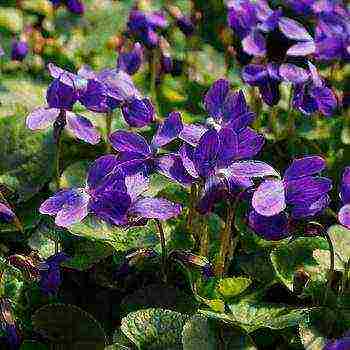 Everyone has their own preferences. Someone likes large inflorescences on tall stems, someone loves smaller and more tender plants. The indisputable choice in most cases is the violet, this flower has long been popular. Most often it is presented in a flowerpot as a houseplant, but sometimes the inflorescence itself becomes an element of a beautiful bouquet.
Everyone has their own preferences. Someone likes large inflorescences on tall stems, someone loves smaller and more tender plants. The indisputable choice in most cases is the violet, this flower has long been popular. Most often it is presented in a flowerpot as a houseplant, but sometimes the inflorescence itself becomes an element of a beautiful bouquet.
Many gardening enthusiasts exclusively grow pansies on their plots as an annual plant. At the same time, there are perennial species of these bright flowers that can decorate the garden for many years.
Perennial violets (Viola) are predominantly May flowers, but can please even earlier. Often violets "come" to the garden from the nearby forest, being proprietorily located in flower beds, rock crevices or under trees. The hand does not rise to weed out such natural self-seeding, and the charming creatures remain in the garden forever, already acquiring the name of the garden violet (or viola).
Look at the photo of what a perennial garden violet looks like, its leaves are arranged on the stem in the next order or collected in a root rosette:
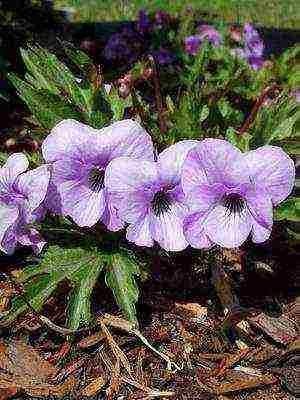
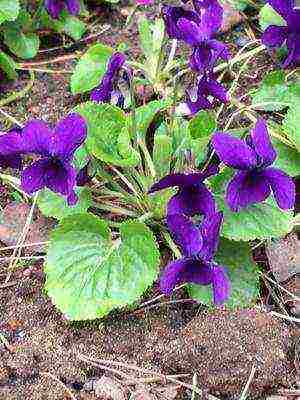
The flowers are usually blue, white, bright red and yellow.
In different countries, this flower has different names, since it has a wide geographical distribution, in Russia it is often called pansies.
Varieties and types of garden violets (pansies): photos, names and descriptions of perennial flowers
There are a great many violets that can be grown in the garden. They are conventionally divided into two groups: some have a horizontal spreading rhizome, while others have all the shoots growing from one root collar.
Among the existing flowers, the following varieties of garden violets can be distinguished:
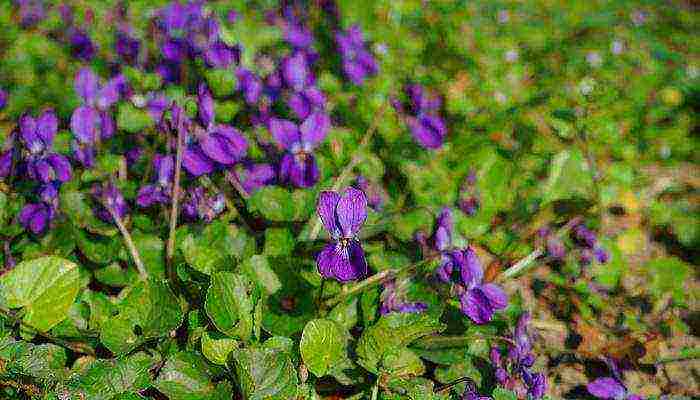
Squat plants scattering in different directions fragrant violets (V. odorata) bloom profusely with purple flowers in spring. This violet is the record holder for the speed of reproduction.

Violet sister (V. sororia) behaves more modestly: the curtain gains only 5-10 cm per year. How varied and large are its flowers!

Grows even slower violet stopper (V. pedatifida). It is a delicate delicate species with leaves that look like small fans. The flowers are lilac, common to violets.
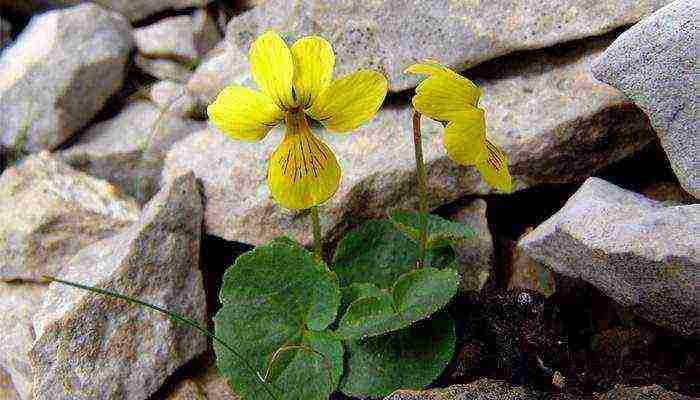
There are garden violet flowers, suitable for rockeries, look at the photo - this is a charming plant with small bright yellow flowers, violet Caucasian (V. caucasica), like the previous species, has a creeping rhizome.

Violet labrador (V. labradorica) in terms of conquering territories can even compete with a fragrant one. Its seeds literally shoot out of the capsules. Self-seeding is very persistent.
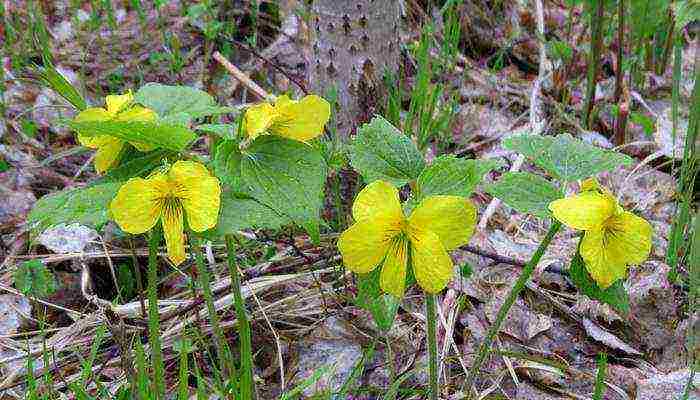
How does the trans-Ural ephemeroid behave violet one-flowered (V. uniflora). In spring it is a bush with large, original-shaped leaves and numerous sunny yellow flowers. From the middle of summer, the plant retires.
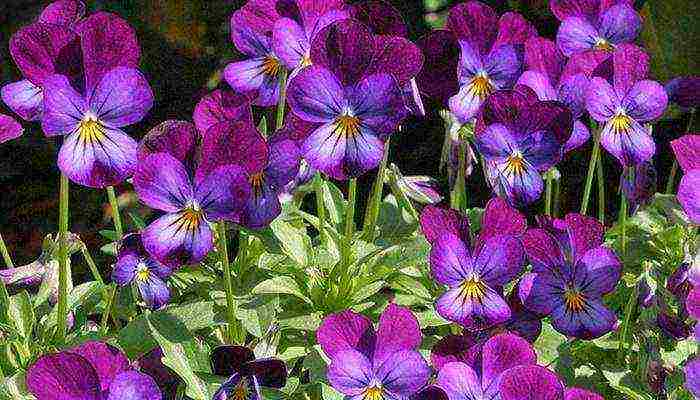
Horned violet (V. cornuta). It is gentle in appearance, it hibernates with green leaves and even retains some buds. Violet blooms from snow to snow, although, of course, the first wave in May is the most violent.
Self-seeding gives an interesting variable color of flowers. But cultural varieties for some reason do not hibernate. They are probably of hybrid origin.
After reading the description of some varieties and types of garden violets, learn about the rules for growing them.
How to plant pansy plants outdoors
The easiest way to propagate viola is by division and cuttings. To do this, it is enough to cut off the leaf with the stem and put it in water until the root appears. It should be noted that even if the reproduction of the plant is not planned, then at least once every three years it must be removed from the soil and divided. Otherwise, due to overly dense growth, the flowers become small and may lose the features of the species.
In species with a horizontally creeping rhizome, a bush can be divided. This is done as follows: you need to moisten the soil well, remove the plant and divide it, disassembling it into full-fledged bushes. Then each plant separately in flowerpots or in open ground.This is done in the spring, before flowering, or in September.
In other species, you can separate the branches from the base of the bush and root them directly in the right place. Under the banks, cuttings of a fragrant horned violet take root in two to three weeks.
The second way of plant propagation is sowing fresh seeds in prepared soil in the fall. The freshness of the seeds plays a very important role in reproductive performance. A garden violet for planting prefers a place in the sun, because in the shade it is often attacked by slugs. Also, these pests parasitize the plant if it grows in a damp place.

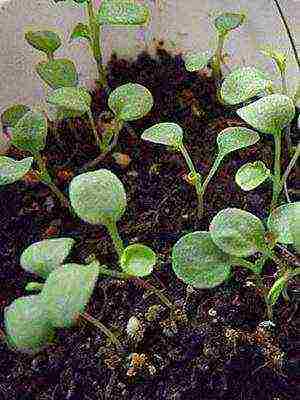
If a decision is made to plant plants by means of seeds, then you need to know what the planting and proper care of the garden violet should be. The seeds must be of good quality and the soil must be properly prepared. It is important to know that sandy soil is not particularly favorable for a perennial violet garden flower. Such soil needs to be improved with organic fertilizer, but not with humus, since it is aggressive to the soil and can burn the delicate roots of the plant.


For perennial garden violets, timely and moderate watering remains an integral part of planting and care. It is worth noting that overflow has a bad effect on this plant, as well as too cold water. This does not mean that it should be warm, but the room temperature of the water for irrigation is simply necessary.
In extremely dry weather, watering should be adequate. With a lack of moisture, the flowers become smaller, the color fades, and the plant stops blooming. To extend the flowering period, rods with faded petals should be removed more often.
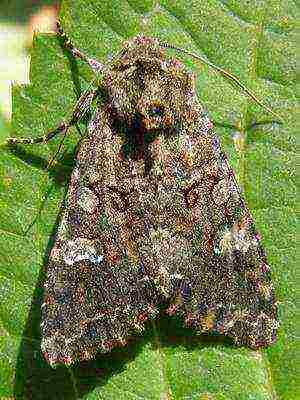
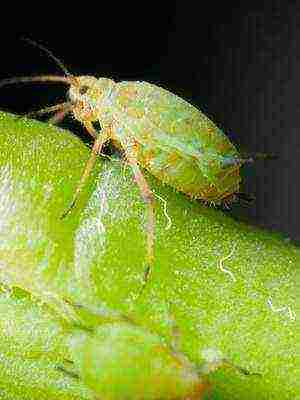
Viols are sometimes affected by pests such as scoops and aphids, so certain measures should be taken in time to protect the plant.
In order to properly handle the perennial garden violet bushes without injuring them when planting and leaving, you can see a photo with a sequence of actions:
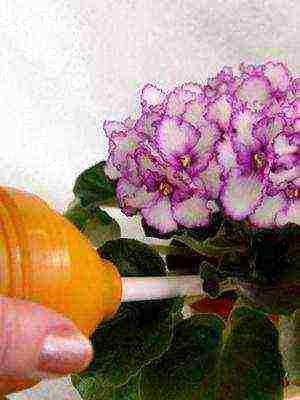
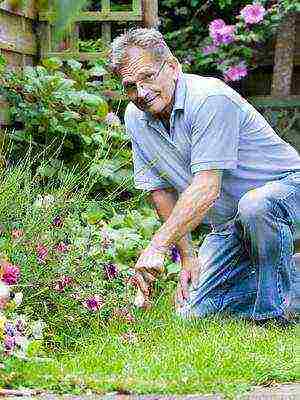
Street perennial violets in garden compositions
Any of the above can be attributed to this type of viola, since all violets grow without much whim in the open field. Their root system is located in such a way that they quickly germinate in loose soil. Such a flower can be a good addition or even a highlight of any composition. Balconies, flower beds, designer slides are decorated with street violets. Various design options for flower beds with street violets can be seen in the photo:

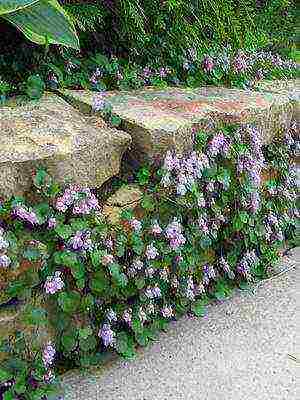
Violets are very plastic and unassuming in growing conditions. They can be grown both in the sun and in shaded areas. This allows you to create clearings from violets under tree crowns among other spring plants. In a garden, perennial street violet is widely used to decorate borders, alpine slides and flower beds. They can be planted with a luxurious carpet between trees and near artificial reservoirs.
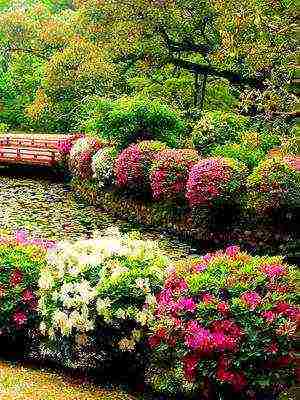

Take a look at the photo of flowers growing by the street violet pond, the variety of shades forms a delightful carpet and complements the landscape design of the resting place.
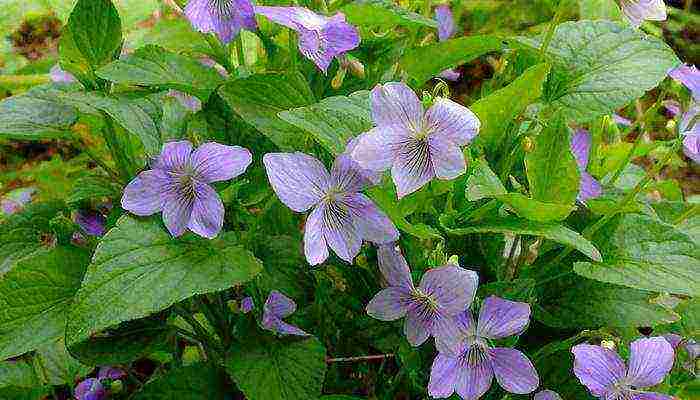
The violet labrador has purple leaves and lilac flowers. It can be planted next to plants that have silvery or yellow leaves.
The contrast is pleasing to the eye. How you can arrange a garden violet in a flower garden so that it sparkles with all the colors, look at the photo:
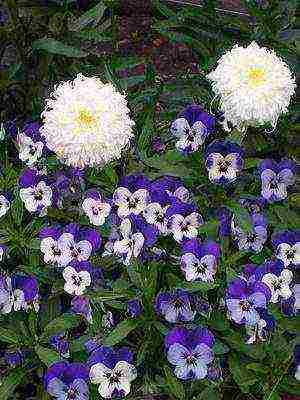


Horned violet, another species actively used in landscape design. It has small peduncles, therefore it is planted in groups.
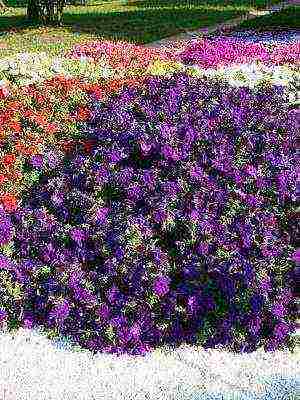

Another feature of it is the short stature of the bushes, therefore, in flower arrangements, it is planted in the foreground. The miniature size made this type a frequenter of balconies and verandas, it is convenient to use it in portable flower beds and flowerpots.
A successful neighborhood in garden compositions will be:
- coniferous shrubs;
- host;
- tulips;
- daffodils;
- hyacinths;
- ferns.
Taller plants will give the viola the much needed shade on a hot day.
Scented garden violets: varieties of perennial flowers
If you look into the history of the appearance of viola in Europe, then the first mentions begin just with a perennial fragrant garden violet. It was she who was the first to decorate the monastery gardens, and after her the mountain variety of the plant soon appeared. The fragrant garden violet is planted as a perennial crop and is often used in folk medicine as a remedy for severe congestive cough.
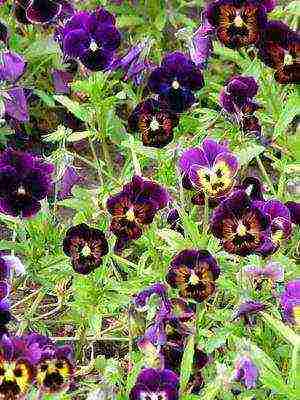
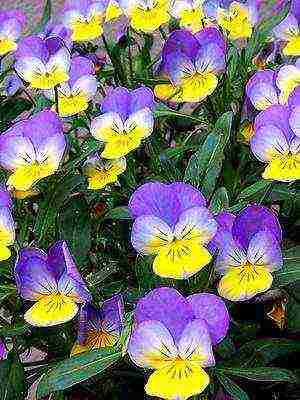
In almost every garden, even a novice amateur florist, you can see how the violet pansies are spreading their petals and bewitching with their tenderness. This flower is one of the types of perennial garden violet. As for the variety in the variety, there are two most famous types of this flower:
- viola tricolor (the so-called initial);
- a hybrid of Wittrock (this is a hybrid of a tricolor species and other more wild varieties: Macedonian, morning, subalpine).
It is the second species (hybrid) that is so popular in gardening because of the variety of colors, there is even an extraordinary black hybrid. The disadvantage of all hybrids in general, and this in particular, is the weak resistance to various diseases.
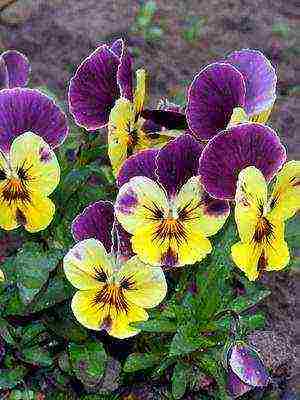
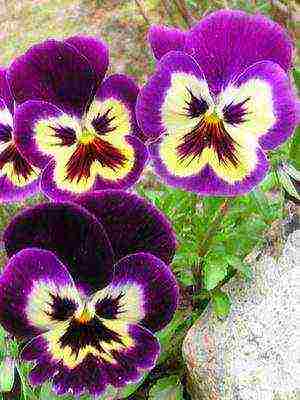
Pay attention to the photo, the flowers of the violet pansies in the lower part of the peduncle are bright yellow, and in the upper part they are purple.
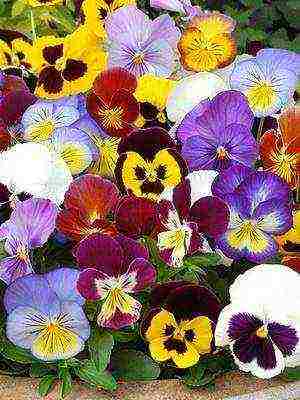
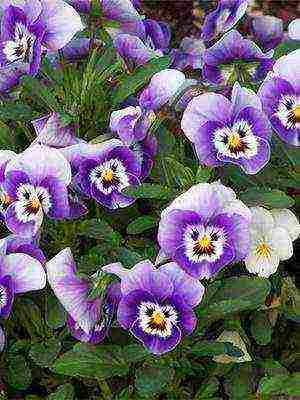
The plant has a very beautiful flowering. Recently, various hybrids of this flower have been bred by breeding, so it can be found in very bright colors and amazing combinations. For example, each petal can be of a different color, or on one of them there are different kinds of dots, streaks, stripes. It looks really beautiful. Look at the photo, how different varieties of pansy flower look:

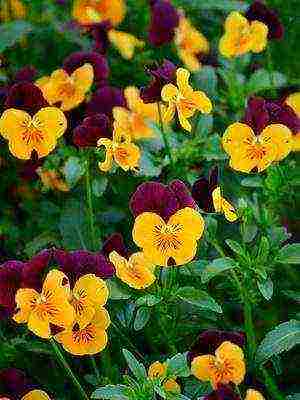
As for the Wittrock variety, he does not have a single classification. There are several of them and each takes into account its own approach:
Difference of variety in size, shape, color:
- bush height (undersized, medium-sized, tall);
- inflorescence size (small flowering and large flowering);
- with a wavy edge (even, slightly wavy, strongly wavy);
- by color (one-color, striped, marble, four-color, multi-colored).
Types depending on the pore of planting, flowering method, color:
- winter varieties (which bloom very early);
- large-flowered (flower diameter up to 10 cm);
- highly wavy and newest varieties (variety series "Swiss Giants").
Look at the photo for pansies of all known varieties and their names:



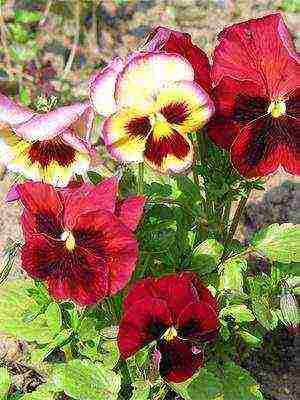
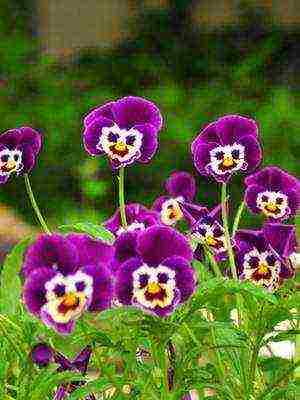
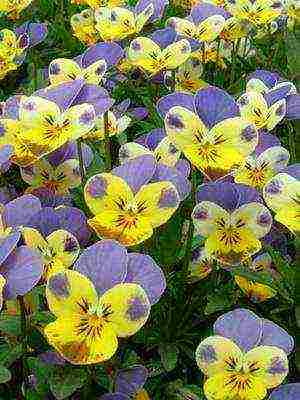
Such a flower can charm anyone. It is not for nothing that for a long time this plant was endowed with magical properties. There is a belief that pansies were used as a means for a love spell. The beauty of these flowers is admired not only by the Slavic peoples, they are popular in different countries. The British, with the help of pansies, confess their feelings to the girls, sending a flower to the chosen one and indicating their name. Inhabitants
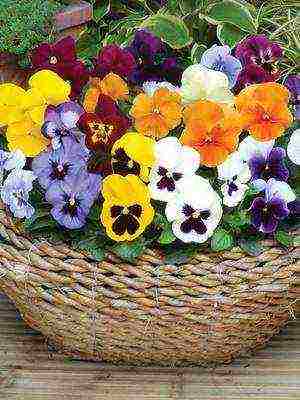
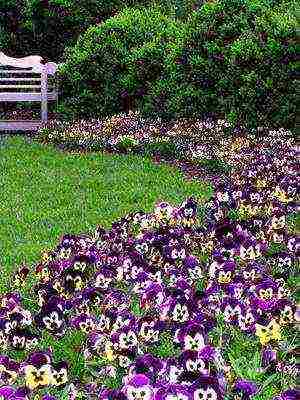
France and Poland use the flower as a symbol of goodbye and parting.
All types of pansies are perennial plant varieties, but most often they are bred as biennials, their inflorescence is similar to a violet. This flower bushes sprawlingly, it grows 15-20 cm in height, the leaves open and stems appear in their axils with a color that reaches 7 cm in diameter.
Take a look at the photo of how a perennial violet looks 3 weeks after planting, if the conditions and care are chosen correctly:
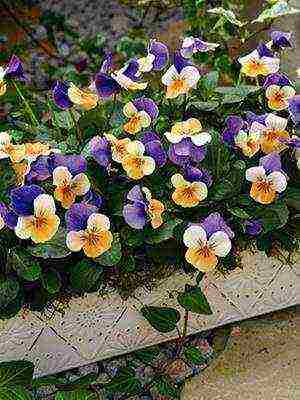
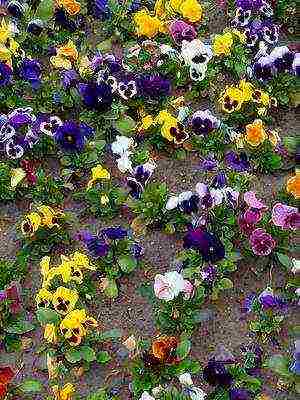
Correct planting of fragrant pansies in open ground
This kind of violet, when planted in the open field and with high-quality care, can please with flowering twice a year. This is very convenient for decorating flower beds or designer flower beds. They bloom in early spring and late autumn, depending on when they were planted. To get flowering in early spring, you need to sow seeds in the summer, that is, six months in advance.If the seeds fall into the ground in May or at the very beginning of summer, then the plants will delight with flowering in the fall.

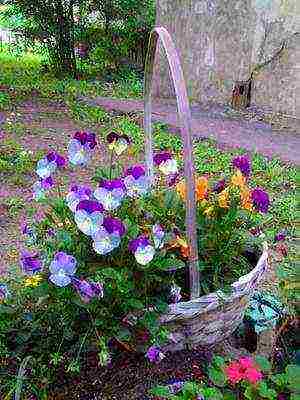
Pansies take root well in the open field, they tolerate wintering well. Of course, if in the fall they were exposed to abundant moisture, and in winter they were not merciful to frost, then freezing is possible. Spring floods can also adversely affect, and under favorable climatic conditions this plant is not particularly whimsical.
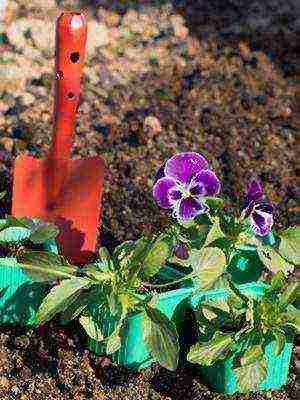
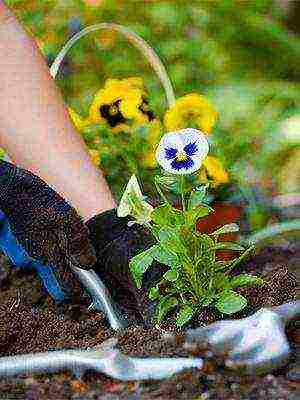
To get good flowering, you need to know how to properly plant pansies in open ground. It should be borne in mind that the land for sowing must be cleared of weeds and well loosened. Therefore, it will be necessary to make beds and place seeds in the holes, avoiding planting density. When planting pansy flowers in open ground, the first shoots should emerge from the ground in a week, or after two, then the seedlings can be thinned out. The distance between the bushes should be about 20 cm. The soil near the bush must be watered and loosened from time to time so that the root system can breathe freely.
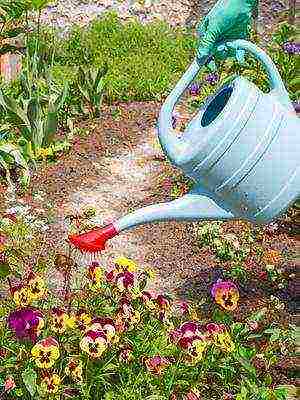
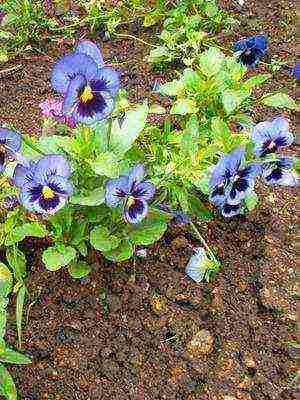
With rational moisture and timely treatment from pansy pests, the next spring will quickly grow and please with abundant flowering. Ready-made flowering plants can be used to decorate all kinds of flower beds and compositions. Florists often decorate wedding bouquets or boutonnieres with violets of this kind. Even a novice amateur gardener can plant pansies in prepared open ground, since this flower does not have any special care requirements and takes root everywhere. It is important to remember that if the flower garden is located in a sunny place, then the flowers will be bright and large, if in the shade - a little smaller and paler.

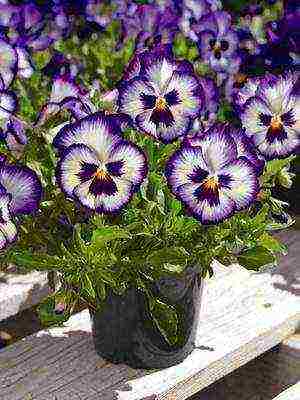
Pansies, regardless of the variety, can be grown both in special greenhouses and in garden conditions in the courtyard of a private house or in the country.
Care when breeding perennial violets
Many violets are not easy to grow through seedlings. At first glance, this is strange, because self-seeding in most species is quite aggressive. The explanation is simple: only fresh seeds germinate well in violets. After storage, they require stratification.
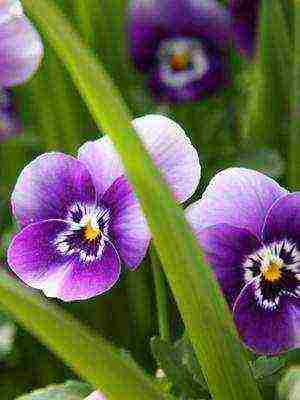
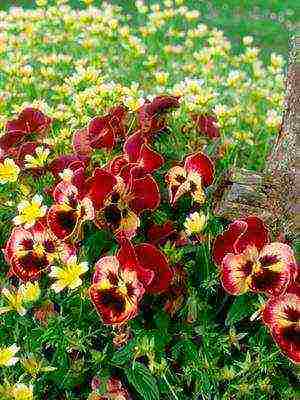
The quantity and quality of flowering can be adjusted by choosing the sowing time and the characteristics of lighting and heating. It is also important to remember that frequent ingress of water on the leaves can provoke rotting, so it is better to water it from below, using a tray, or soak the soil under a growing flower.
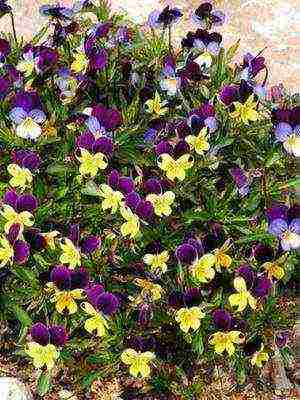

A perennial garden violet does not require spraying when planting and caring for it, but moist air for it, like for most plants, is necessary. To satisfy this need, it is enough to put a small container of water next to the flowerpot. If the plant is outdoors, then more often spray the surrounding area or neighboring plants to provide the necessary moisture level on hot days (approximately 50%).

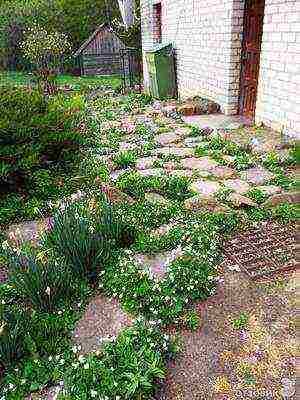
It must be remembered that violets, although not whimsical plants, are afraid of drafts. This is especially true for flowers that are in the room. And street copies are also better placed in a cozy place.

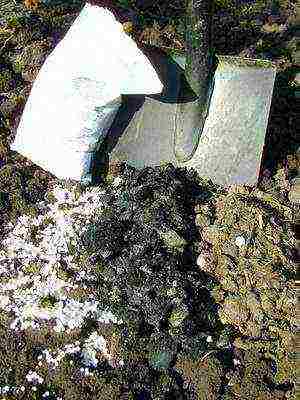
Fertilizer plays an important role in the cultivation of viols. Now there are many different solutions that you can add when watering, or treat the roots with them when planting a plant in the soil. To choose a good fertilizer for violets, you need to focus on the agent for flowering plants. You need to process the plant, following the instructions and dosage indicated by the manufacturer.
How not to make a mistake when buying violets
When the choice fell on a violet for growing flowers at home, then you need to know how not to make a mistake when buying.

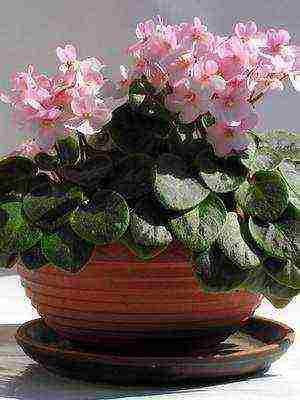
Of course, to purchase seeds, you can explore the assortment offered by various stores. In this case, you need to pay attention to the expiration date and the manufacturer.It would be nice to first read reviews of a similar product on the Internet. You can also heed the advice of experienced friends or florists. But the best option would be to purchase these seeds from people who are breeding viols. In most cases, they take a responsible approach to collecting seeds, which will give good flowering in the future.
If you decide to buy ready-made violets in a flowerpot, then you can use the following tips:
- The plant should have dense leaves, no spots.
- The ends of the leaves should not be dry.
- Lethargy should not be present.
- The violet should be in bloom.
- There should be no smell of rot or delight from the soil.
Choosing the right violet for the interior, you also need to take into account some features:
- Color combination.
- The size of the flowerpot and the outlet itself.
- Lighting of the intended place (the pale flower will become even paler if it stands where there is little light).
- If the walls of the room are dark in color, then the flower should be lighter and brighter.
- The color and style of the flowerpot also needs to be considered.
Perennial violets can be selected in the photo below:
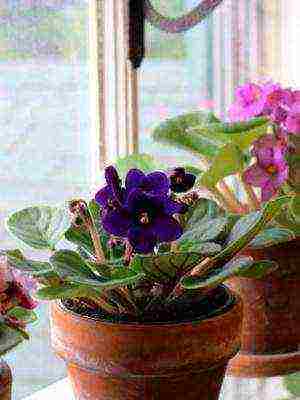
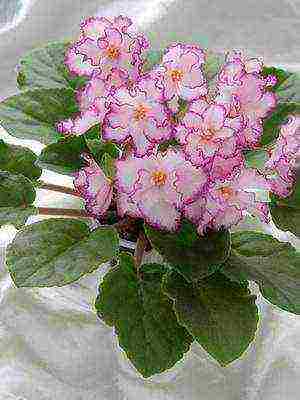
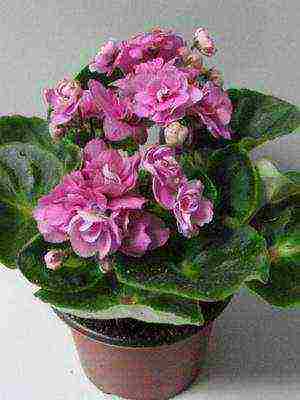
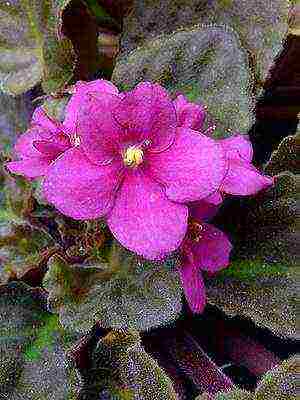
Viola of any kind can successfully blend into a variety of interiors. These flowers look equally harmonious both outdoors and indoors. The main thing will be determined where is the most suitable place for their placement.
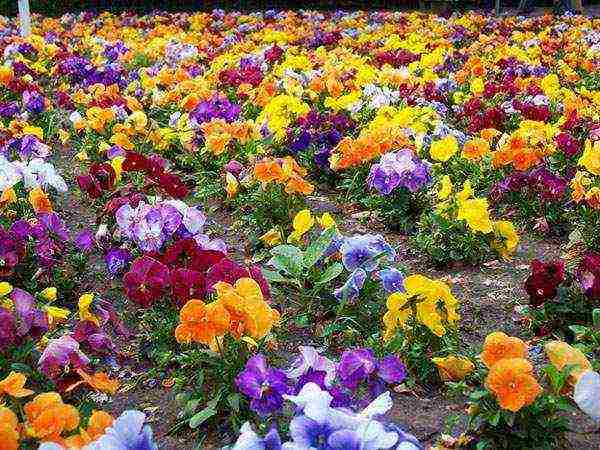 Pansies, which are known under the elegant name viola or under the academic name - violet Vitrokka, will help to create a multi-colored velvet carpet in your corner of paradise. The traditional colors of this culture are purple and yellow. Over time, breeders have developed about 200 varieties with stunning shades. So the garden violet became a lush blooming and beautiful decoration of the garden.
Pansies, which are known under the elegant name viola or under the academic name - violet Vitrokka, will help to create a multi-colored velvet carpet in your corner of paradise. The traditional colors of this culture are purple and yellow. Over time, breeders have developed about 200 varieties with stunning shades. So the garden violet became a lush blooming and beautiful decoration of the garden.
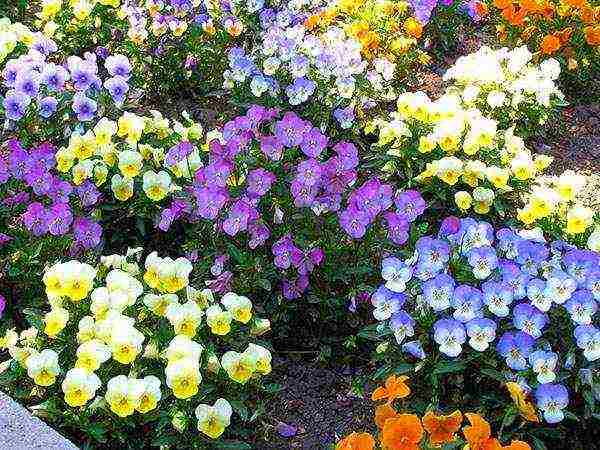 The violet family has many features in planting, care, and cultivation. To enjoy such beauty both in spring and autumn, you need to know some nuances. You should also choose the right variety for planting.
The violet family has many features in planting, care, and cultivation. To enjoy such beauty both in spring and autumn, you need to know some nuances. You should also choose the right variety for planting.
Flower characteristic
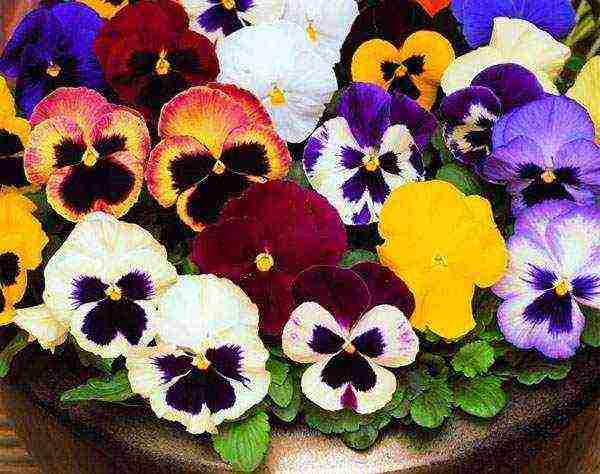 The shades of the petals are so saturated that even in the photo the pansies look incomparable. You can see this beauty in early spring, when it gets warmer. Some varieties are pleasing to the eye throughout the summer, because they easily tolerate hot weather. Others feel great in the velvet season, as they can even withstand frost. Among other things, varieties have been bred that are resistant to low temperatures. All this variety is classified as follows.
The shades of the petals are so saturated that even in the photo the pansies look incomparable. You can see this beauty in early spring, when it gets warmer. Some varieties are pleasing to the eye throughout the summer, because they easily tolerate hot weather. Others feel great in the velvet season, as they can even withstand frost. Among other things, varieties have been bred that are resistant to low temperatures. All this variety is classified as follows.
Frost resistance
These plants can bloom even at the end of February. Low temperatures in the morning or light frost will not spoil the delicate flowers. Gardeners carefully select winter-hardy specimens for their summer cottage. These varieties mainly include:
For all winter-hardy varieties, the compact size of the shrub is characteristic (the flower diameter reaches 6 cm). Some varieties of this viola produce abundant blooms. It is they who delight the owners with their charm for a long time.
Flower size and shape
 They come in small caliber: 3-5 cm (Snow Maiden, blue boy and little red riding hood). The buds bloom from small bosoms. Pansy flowers are solitary, but together they make up a gorgeous look. Such giant varieties look especially luxurious:
They come in small caliber: 3-5 cm (Snow Maiden, blue boy and little red riding hood). The buds bloom from small bosoms. Pansy flowers are solitary, but together they make up a gorgeous look. Such giant varieties look especially luxurious:
- golden yellow;
- Majestic Jainst or super;
- White;
- Magnum;

- blue.
The peduncle of such titans reaches 10-12 cm in length, and the diameter of the flower is more than 7 cm. They can be monochromatic, as well as with exquisite spots or patterns. Among the large-leaved varieties, the most popular are:
The length of the branched stem is 10 cm, and the diameter of the flowers does not exceed 5 cm. The delicate petals of a tricolor violet have both smooth edges and wavy (jagged) edges.  The crimped petals of the Flamenco, Chalon Supreme and Rococo varieties have an exotic look, as well as an unusual variegated color (shaded color in the center).
The crimped petals of the Flamenco, Chalon Supreme and Rococo varieties have an exotic look, as well as an unusual variegated color (shaded color in the center).
Color spectrum
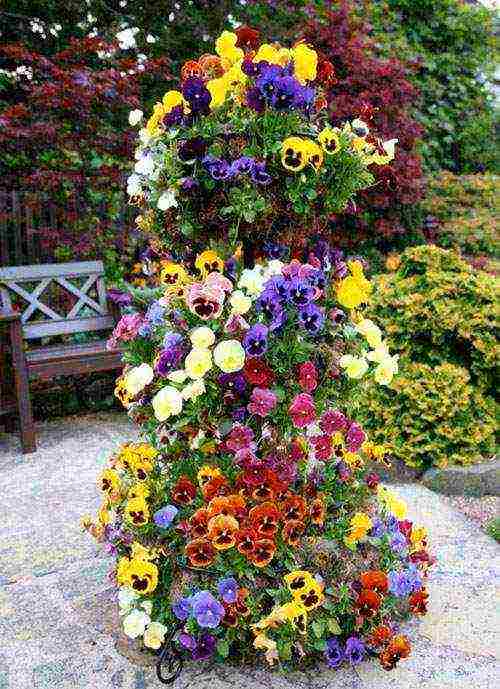 The palette of Vitrokka violets is striking in its variety.On the flowerbed, tricolor specimens look unusually in dark shades of blue, purple and red. Violas, snow-white with a greenish tint, will become a breathtaking property of the garden. At the same time, blue, lilac, yellow and burgundy (with bizarre spots) exhibits will add a touch of romance to the suburban area.
The palette of Vitrokka violets is striking in its variety.On the flowerbed, tricolor specimens look unusually in dark shades of blue, purple and red. Violas, snow-white with a greenish tint, will become a breathtaking property of the garden. At the same time, blue, lilac, yellow and burgundy (with bizarre spots) exhibits will add a touch of romance to the suburban area.  Varieties with contrasting stripes, borders and incomparable eyes look special near the house. Such a colorful description of pansies is endless, because it is difficult to see all 250 varieties at once.
Varieties with contrasting stripes, borders and incomparable eyes look special near the house. Such a colorful description of pansies is endless, because it is difficult to see all 250 varieties at once.
Bush height
 Low-growing crops reach 15 cm in height, and giants - up to 30 cm. In diameter, a viola bush can grow from 6 to 12 cm. Since this plant perfectly tolerates shaded areas, it can be safely grown in a garden between trees.
Low-growing crops reach 15 cm in height, and giants - up to 30 cm. In diameter, a viola bush can grow from 6 to 12 cm. Since this plant perfectly tolerates shaded areas, it can be safely grown in a garden between trees.
The flowering period can be artificially extended. To do this, it is necessary to constantly remove the wilting flowers, preventing them from turning into seed bolls.
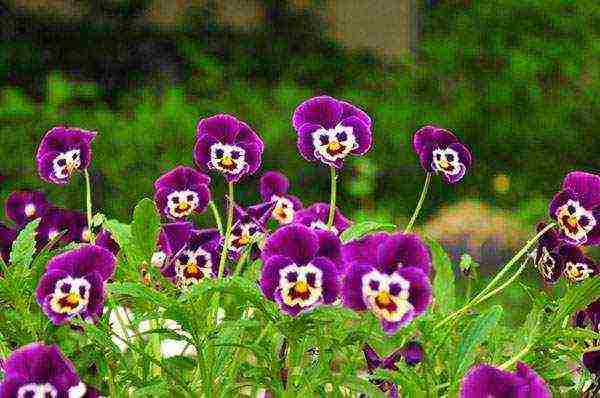
Flowering period
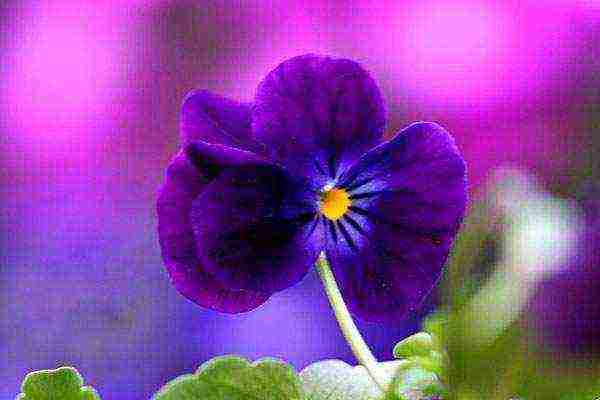 As already noted, pansies are able to delight with their stunning flowering in the season of the year that the owners want. So it can:
As already noted, pansies are able to delight with their stunning flowering in the season of the year that the owners want. So it can:
- March or April;
- summer months (withstand heat and drought);
- autumn period (snowfalls and a drop in temperature are calmly tolerated).
 Therefore, the garden violet can be transplanted into pots (plastic boxes) and decorate balconies, facades of houses, loggias, as well as windows with them. To do this, you need to periodically loosen the ground and water the plants.
Therefore, the garden violet can be transplanted into pots (plastic boxes) and decorate balconies, facades of houses, loggias, as well as windows with them. To do this, you need to periodically loosen the ground and water the plants.
It is important to ensure that the soil is not wet for a long time, because the roots can begin to rot.
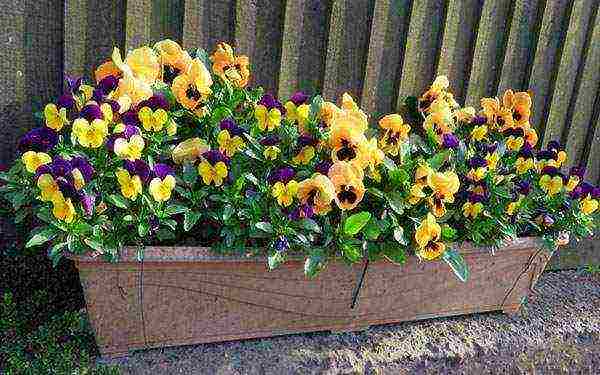
Planting secrets
 The first step is to choose a variety and a suitable place for it on the site. Many housewives prefer large-caliber varieties. Single-flowered specimens look amazing in a flower bed surrounded by other flowers. However, as experience shows, it is the violas with small petals that are the most hardy.
The first step is to choose a variety and a suitable place for it on the site. Many housewives prefer large-caliber varieties. Single-flowered specimens look amazing in a flower bed surrounded by other flowers. However, as experience shows, it is the violas with small petals that are the most hardy. 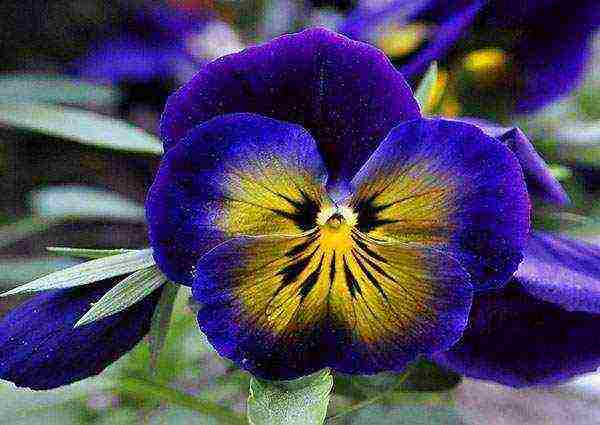 Such crops survive both in the rainy season and with sudden changes in temperature. Therefore, in the northern regions it is better to plant small-flowered varieties, because in the southern latitudes the inflorescences become smaller. The same applies to giant varieties if they grow for a long time in hot and dry climates.
Such crops survive both in the rainy season and with sudden changes in temperature. Therefore, in the northern regions it is better to plant small-flowered varieties, because in the southern latitudes the inflorescences become smaller. The same applies to giant varieties if they grow for a long time in hot and dry climates.
It is better to plant a crop in an open area. Access to heat and direct rays should be at least 5-7 hours per day. It is worth watering the flower beds once a week. Depending on the weather, you can do it twice.
Pick-up location
 It is important to consider that pansies are perennials and annuals. This means that they are bred for both one year and two or three. The period of growth largely depends on the labor that the gardener is willing to invest in these garden exhibits, and processing technologies. It was noticed that if you feed the soil with fertilizers, at least once a week, the stem grows faster, and the inflorescences become more luxuriant.
It is important to consider that pansies are perennials and annuals. This means that they are bred for both one year and two or three. The period of growth largely depends on the labor that the gardener is willing to invest in these garden exhibits, and processing technologies. It was noticed that if you feed the soil with fertilizers, at least once a week, the stem grows faster, and the inflorescences become more luxuriant. 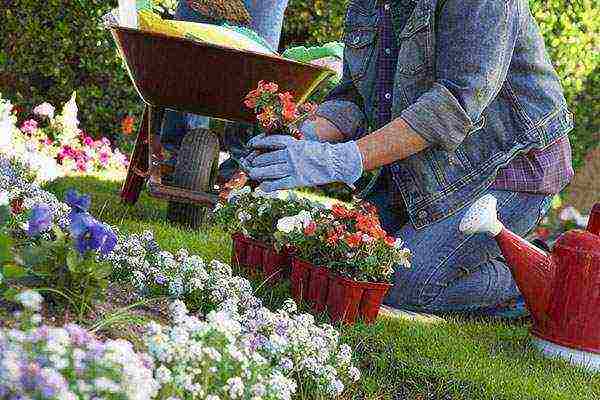 The following parameters will be favorable conditions for planting and caring for pansies:
The following parameters will be favorable conditions for planting and caring for pansies:
- Soil type. Dry soil mixed with sand or stones is not suitable for viola. The soil should be fertilized in order to saturate the young roots with nutrients. It must contain enough moisture.
- Shading degree. It is important to find a middle ground here. A thick shadow will lead to the degeneration of the plant, and the scorching sun will destroy it.
- Good care. Takes care of the regular watering of the sprouts. Around the rhizome (at a distance of 2-3 cm), it is worth making mulch from leaves or dried grass. From time to time you need to pluck spoiled stems or petals.
When an amateur gardener has decided on a place and has chosen a suitable variety, then you can start the sowing process. There are several ways to do this.
Boarding time
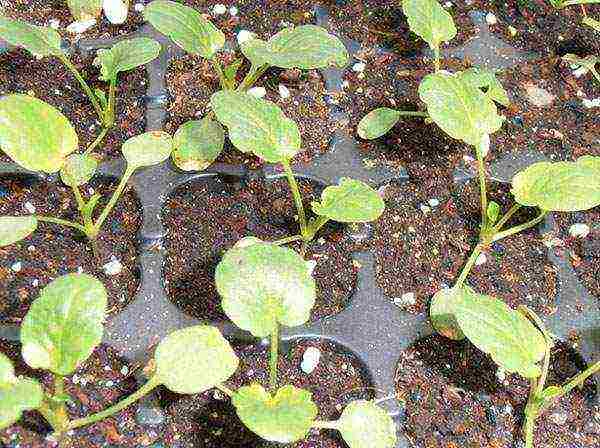 The first option is to grow pansies yourself from seeds. When to plant depends on the period in which the grower wants to get a thriving crop. These varieties germinate well at a temperature of 16-18 ° C.So, if you sow seeds in a container in winter (at the end of January), then after 2-3 months the seedlings can be transplanted into the soil. At the same time, it is important to correctly calculate the date of the last frost in advance.
The first option is to grow pansies yourself from seeds. When to plant depends on the period in which the grower wants to get a thriving crop. These varieties germinate well at a temperature of 16-18 ° C.So, if you sow seeds in a container in winter (at the end of January), then after 2-3 months the seedlings can be transplanted into the soil. At the same time, it is important to correctly calculate the date of the last frost in advance.  You can see what time they were last year, and from that date you can count 3 months. This will be the date of the dive into the open ground, only next year.
You can see what time they were last year, and from that date you can count 3 months. This will be the date of the dive into the open ground, only next year.
Those who plan to see this beauty in their garden in the fall should sow during July. Then by September, when the heat subsides, the sprouts will be ready to be transplanted into the ground.
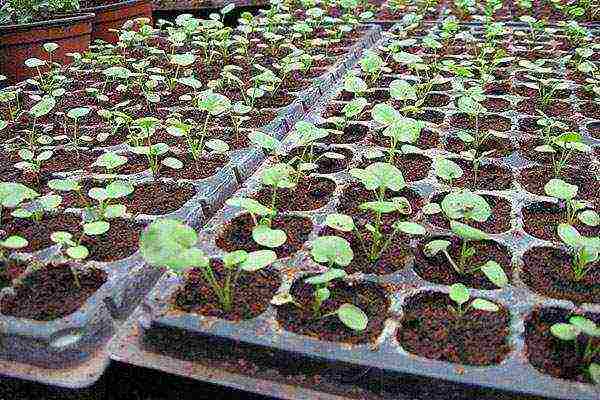 Perennial crops can be sown directly outdoors in mid-summer. However, the sun can scorch tender sprouts, so they should be covered with greenery, but so that there is no greenhouse. By the end of August, the seedlings should get stronger in order to successfully survive the winter. To do this, they need to be watered every 7 days and fertilized by alternating mineral and organic fertilizing. At the end of summer, the sprouts are transplanted to another place. At the same time, it is important not to let them bloom, because this will deplete the plant before wintering.
Perennial crops can be sown directly outdoors in mid-summer. However, the sun can scorch tender sprouts, so they should be covered with greenery, but so that there is no greenhouse. By the end of August, the seedlings should get stronger in order to successfully survive the winter. To do this, they need to be watered every 7 days and fertilized by alternating mineral and organic fertilizing. At the end of summer, the sprouts are transplanted to another place. At the same time, it is important not to let them bloom, because this will deplete the plant before wintering.  As a result, in the spring you can take a lovely photo of pansy flowers and enjoy their delicate fragrance.
As a result, in the spring you can take a lovely photo of pansy flowers and enjoy their delicate fragrance.
Landing nuances
 Garden viols, although not very picky flowers, still require special treatment. When sowing seeds, you must follow a number of simple rules:
Garden viols, although not very picky flowers, still require special treatment. When sowing seeds, you must follow a number of simple rules:
- loosen and slightly moisten the soil;
- mix seeds with sand so as not to sow too thick;
- it is not recommended to bury the seeds deeply in the ground;
- they need to be watered with a watering can with a fine strainer so as not to wash off the seed with water;
- store the tray for the first week in a dark place;
- then it is important to place the container in a more illuminated room;
- periodically, a box with seedlings, which are already 25 days old, is taken out into fresh air (at a temperature of + 6 ° C) in order to harden the sprouts.
When transplanting seedlings into open ground, it is important to adhere to a special system. You need to dive culture in early May. And literally in 3-4 weeks inflorescences will appear. It is advisable to transplant tubers in the evening, when it is cool and there is no sun. They should be planted at a distance of 25 cm, because they are able to grow. If forecasters promise frosts, then the beds should be covered with straw.
Strong winds can damage the plant. Therefore, it is important to make a protective fence for the flower bed with viola.
Care and protection against pests
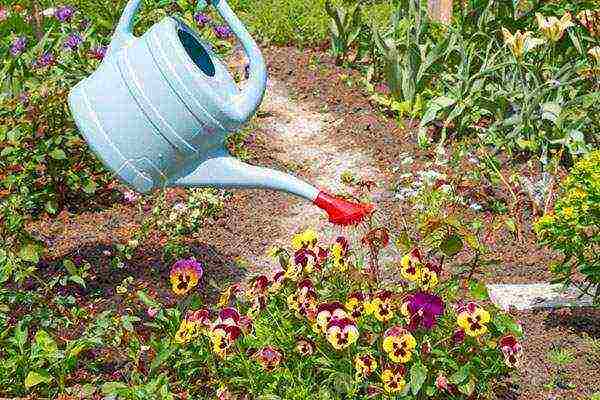 Pansies will bloom wildly with proper care and conditions. A winter without snow is a destructive factor for plants. Therefore, it is advised to cover the beds with mulch and a special tarpaulin. Among other things, it is important to keep an eye on the following:
Pansies will bloom wildly with proper care and conditions. A winter without snow is a destructive factor for plants. Therefore, it is advised to cover the beds with mulch and a special tarpaulin. Among other things, it is important to keep an eye on the following:
- The soil should always be soft and moist. Therefore, the soil must be constantly loosened. Moisten the soil only after it is completely dry.
- Feed with fertilizer. You cannot do this with fresh manure. It is better to use humus in a proportion of 5 kg per square meter. m or compost.
- The place should be well ventilated.
- Make a box hut to protect from direct rays.
- Defective shoots should be pinched off immediately.
- Remove dried leaves.
These simple rules promote the lush flowering of the viola. Yet pests are a danger to her. These can be such manifestations:
- Stem and root rot.
- Ticks, slugs, and scoops. If small holes appear on the leaves, then this is their job. Such pests can be collected by hand or treated with a special tool.
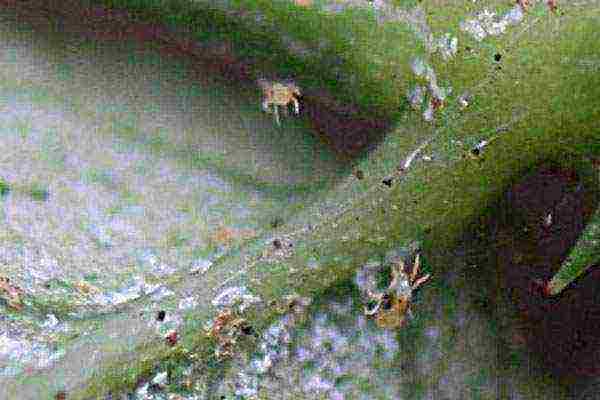
- Aphid. The first signs are dry leaves and buds, as well as a sticky discharge. The soapy solution destroys aphids.
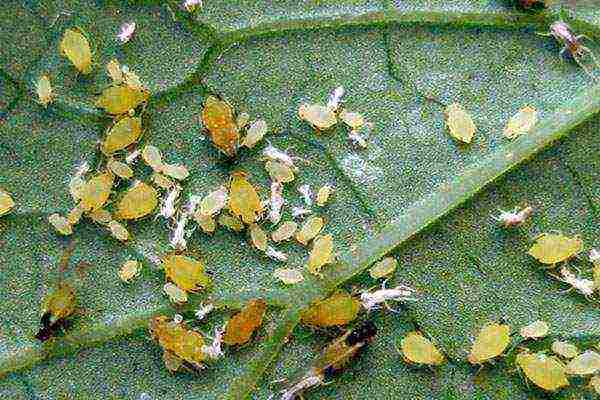
- Yellow and brown spotting. This is the action of harmful bacteria. Copper oxychloride eliminates the pest.
- White bloom or powdery mildew. Treat the bush with any fungicide.
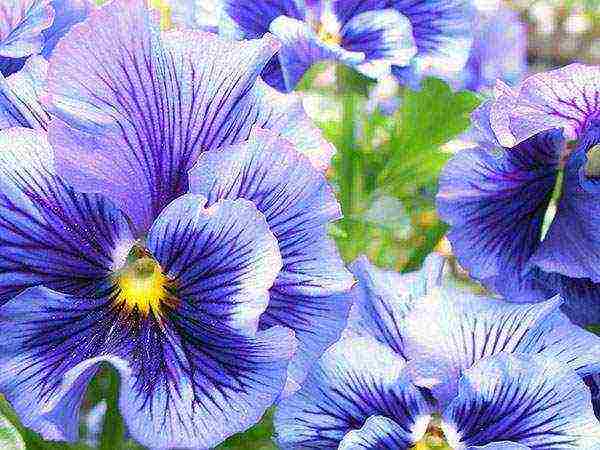 This plant is not really whimsical. Therefore, pests and diseases almost in rare cases interfere with the growing season, as well as the lush flowering of the crop. As a result, you can always enjoy the beauty of pansies.
This plant is not really whimsical. Therefore, pests and diseases almost in rare cases interfere with the growing season, as well as the lush flowering of the crop. As a result, you can always enjoy the beauty of pansies.
How to grow pansies - video


